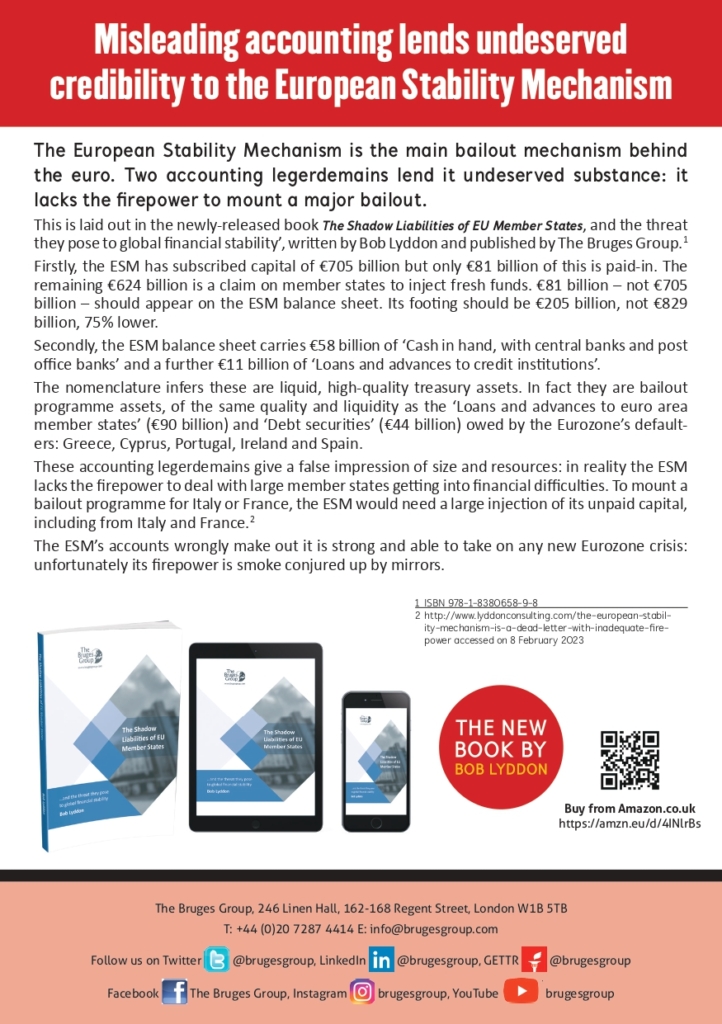Published on 24th April 2023
The European Stability Mechanism is the main bailout mechanism behind the euro. Croatia recently joined it upon adopting the euro.[1] The ESM uses two accounting tricks to make it appear larger and more robust than it actually is, disguising that it lacks the firepower to deal with a major incident.
This is laid out in the newly-released book ‘The shadow liabilities of EU Member States, and the threat they pose to global financial stability’, written by Bob Lyddon and published by The Bruges Group.[2]
The ESM has subscribed capital of €705 billion but only €81 billion of this is paid-in. The remainder is a claim on the member states to inject fresh funds. The ESM balance sheet wrongly carries the full €705 billion of capital on the liabilities side, and the unpaid portion of €624 billion on the asset side, when it is not an asset but a contingent claim. It has no place on a balance sheet.
The European Investment Bank, whose capital structure is similar, correctly nets its unpaid capital of €227 billion off against its subscribed capital of €247 billion on the liabilities side of its balance sheet without claiming the existence of any related asset.[3] The ESM’s balance sheet footing ought to be lower by €624 billion.
There is a second significant accounting legerdemain: the ESM balance sheet carries €58 billion under the heading of ‘Cash in hand, with central banks and post office banks’ and a further €11 billion under the heading of ‘Loans and advances to credit institutions’.
These treatments infer that the captioned assets are separate from the ESM’s bailout programmes, that they are of higher quality and liquidity than bailout programme assets, and that they are free resources available to be mobilized for new bailout programmes.
In reality they are part-and-parcel of the existing bailout programmes for the five debtor members and are of the same quality and liquidity as ‘Loans and advances to euro area member states’ (€90 billion) and ‘Debt securities’ (€44 billion).
These four balance sheet positions totalled €203 billion and equated to the bailout programmes as they stood at the end of 2020.[4] The ESM had no banking assets outside of its bailout programmes, contrary to what the presentation of its accounts infers.
The inflation of the ESM’s balance sheet size and the misrepresentation that it has liquid assets at its disposal create an impression that it has firepower in reserve to deal with more and larger member states getting into difficulties. It doesn’t: the unpaid capital of any new borrowers has to be deducted from the ESM’s resources in order to ascertain its firepower. Any proposed bailout for Italy or France on a meaningful scale would reveal the ESM’s firepower to be almost nil.[5]
The ESM’s accounts make out it is strong and able to take on any new Eurozone crisis, but this is an illusion. It is all smoke-and-mirrors.
[1] https://www.esm.europa.eu/croatia accessed on 8 February 2023
[2] ISBN 978-1-8380658-9-8
[3] EIB 2020 Financial Report p. 39
[4] ESM 2020 Annual Report p. 68
[5] http://www.lyddonconsulting.com/the-european-stability-mechanism-is-a-dead-letter-with-inadequate-firepower accessed on 8 February 2023

